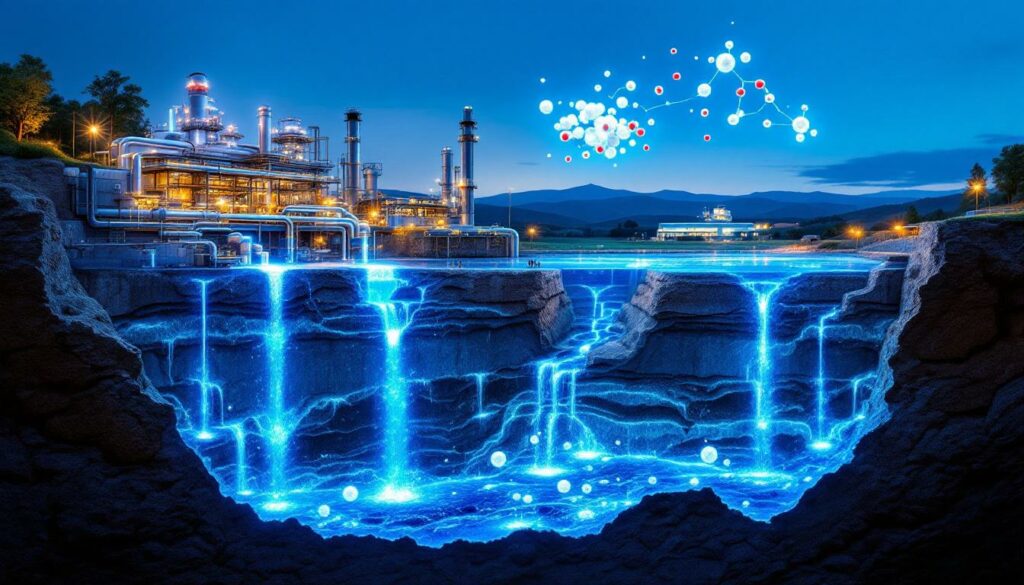Understanding the Marcellus Shale Lithium Opportunity
The Marcellus Shale region, particularly in Pennsylvania, represents an emerging frontier for lithium production in the United States. This geological formation, traditionally known for its natural gas reserves, contains significant amounts of lithium in its produced water—a byproduct of oil and gas operations that was previously considered waste.
According to Anurag Bajpayee, CEO of Gradiant, "This strategic investment in the Marcellus Shale could supply up to 50% of U.S. lithium needs, validating our technological maturity and securing long-term domestic supply." This bold projection underscores the strategic importance of this development for America's critical mineral supply chain.
The opportunity stems from the discovery that wastewater from conventional oil and gas operations contains lithium concentrations that, while previously overlooked, can now be economically extracted using innovative technologies. This creates a unique dual benefit: addressing wastewater management challenges while simultaneously producing a critical battery material essential for the critical minerals energy transition.
The strategic value of this lithium source cannot be overstated. As the United States seeks to reduce dependency on imported critical minerals, domestic lithium production from unconventional sources like the Marcellus Shale could significantly strengthen supply chain resilience and support growing demand from the electric vehicle and energy storage sectors.
The Untapped Potential of Oilfield Produced Water
Oil and gas operations in the Marcellus Shale generate millions of gallons of produced water daily. This wastewater traditionally represented a disposal challenge and environmental liability. However, it now represents a valuable resource due to its lithium content.
While conventional lithium production relies on either hard rock mining or evaporation ponds in desert regions, the Marcellus approach taps into an existing waste stream. This creates economic value from what was previously a cost center for energy companies while potentially reducing environmental impacts associated with traditional lithium extraction methods.
The concentration of lithium in Marcellus produced water varies by location but is sufficient in many areas to support commercial extraction operations. By processing this brine, operators can recover lithium while simultaneously treating water that would otherwise require expensive disposal.
Strategic Importance for U.S. Lithium Supply
The development of lithium production in the Marcellus Shale aligns perfectly with national objectives to secure domestic supply of critical minerals. The U.S. currently imports approximately 98% of its lithium, creating vulnerability in the supply chain for batteries and other advanced technologies.
By developing the Marcellus resource, the U.S. could:
- Reduce dependency on lithium imports from countries like Australia, Chile, and Argentina
- Shorten supply chains for battery manufacturers
- Create domestic jobs in extraction and processing
- Improve national security through resource independence
- Support the growth of U.S. battery manufacturing capacity
Industry projections suggest that at full development, the Marcellus Shale could become one of the most significant lithium resources in North America, complementing other emerging domestic sources.
How Lithium Extraction Works in the Marcellus Shale
The extraction of lithium from oilfield produced water in the Marcellus Shale utilizes advanced technologies that differ significantly from traditional lithium mining methods. Rather than depending on solar evaporation or hard rock mining, these innovative processes focus on efficiently separating lithium from the complex brine solution.
The process begins with produced water, which contains not only lithium but also various other minerals and contaminants. This water undergoes multiple treatment stages designed to isolate and concentrate the lithium while removing impurities.
Innovative Extraction Technologies
The technological approach to extracting lithium from Marcellus Shale produced water involves sophisticated filtration systems, ion exchange resins, and specialized membrane technologies. These methods are designed to selectively capture lithium ions while allowing other elements to pass through.
Unlike traditional lithium brine operations that require months of solar evaporation in large ponds, these direct lithium extraction (DLE) technologies can process water continuously, regardless of weather conditions or seasons. This enables year-round production with a significantly smaller physical footprint.
The extraction technologies have been refined through years of research and development, resulting in systems that can efficiently process the specific chemical composition of Marcellus Shale produced water. These technologies represent a significant advancement over early lithium extraction attempts from oilfield brines.
The EC² Platform: Extraction, Concentration, and Conversion
Leading companies in the Marcellus Shale are implementing integrated end-to-end processes that combine extraction, concentration, and conversion (EC²) technologies. Gradiant, through its subsidiary Alkali, has pioneered this approach at its facility in Montrose, Pennsylvania.
The EC² platform achieves remarkably high lithium recovery rates—up to 97% from produced water—while producing battery-grade lithium carbonate with 99.5% purity. This level of performance demonstrates the commercial viability of the technology and its potential for broader deployment.
The process works in three distinct stages:
- Extraction: Selective separation of lithium from the produced water
- Concentration: Increasing the lithium concentration to levels suitable for processing
- Conversion: Transforming the concentrated lithium solution into battery-grade lithium carbonate
This integrated approach enables efficient production without the need for separate facilities for each processing stage, reducing capital costs and improving operational efficiency.
Environmental Advantages Over Traditional Mining
Lithium production from oilfield produced water offers several significant environmental mining benefits compared to conventional lithium mining operations:
- Reduced land disturbance: No need for large evaporation ponds or open-pit mines
- Lower water consumption: Process uses existing wastewater instead of consuming fresh water
- Smaller carbon footprint: Shorter transportation distances and integration with existing infrastructure
- Waste stream utilization: Creates value from what was previously considered a waste product
- Reduced disposal needs: Decreases the volume of produced water requiring injection well disposal
These environmental advantages make the Marcellus Shale lithium production approach particularly attractive in an era of increasing focus on sustainable resource development and environmental stewardship.
Key Players in Marcellus Shale Lithium Production
The development of lithium production from the Marcellus Shale involves several key players who are pioneering this innovative approach to critical mineral extraction. These companies bring together expertise in water treatment, mineral processing, and lithium refining.
Gradiant and Alkali's Pioneering Facility
Gradiant, through its wholly-owned subsidiary Alkali, has established the world's first commercial facility to extract lithium from oilfield produced water in Montrose, Susquehanna County, Pennsylvania. This landmark project represents a significant milestone in the development of unconventional lithium resources in North America.
"We now have a fully operational lithium production asset in the United States that proves the EC² platform's delivery capability," states Anurag Bajpayee, CEO of Gradiant. "This isn't a concept—it's an operating facility demonstrating that clean, domestic lithium production is viable and scalable."
The company has implemented a vertically integrated model that includes ownership of equipment, land, water rights, mineral rights, and permits to ensure operational control and efficiency. This comprehensive approach allows for seamless coordination across the entire production process, from water acquisition to final product delivery.
Alkali's facility represents a significant capital investment in the region and demonstrates confidence in the long-term viability of lithium extraction from produced water. The company's technology has successfully proven the concept at commercial scale, paving the way for potential expansion throughout the Marcellus Shale region.
Commercial Partnerships and Offtake Agreements
Alkali has secured multi-year offtake agreements to supply up to 5,000 metric tons of battery-grade lithium carbonate annually to a U.S. lithium-ion battery manufacturer. These agreements demonstrate market confidence in the viability of Marcellus Shale lithium production and establish critical links in the domestic battery supply chain.
According to company statements, the offtake partner will use the lithium in manufacturing batteries for electric vehicles and energy storage systems, directly supporting the clean energy transition. This commercial relationship validates the quality of the product and ensures a stable market for the facility's output.
Such partnerships are essential for the development of new lithium sources, as they provide revenue certainty that supports capital investment in production facilities. They also help to establish domestic supply chains that reduce reliance on imported materials for critical clean energy technologies.
Technology Providers and Service Companies
The development of lithium extraction in the Marcellus Shale involves collaboration with specialized service providers and technology companies that contribute expertise in:
- Water treatment and processing systems
- Selective lithium extraction technologies
- Ion exchange resins and membranes
- Chemical conversion processes
- Quality control and assurance systems
- Process automation and monitoring
These supporting companies provide critical components and services that enable the primary operators to achieve their production goals. Their specialized knowledge and technologies are essential to the success of these innovative lithium production facilities.
The growth of lithium production in the region is creating opportunities for companies throughout the supply chain, from equipment manufacturers to analytical service providers. As the sector expands, this ecosystem of supporting businesses is likely to grow as well.
Economic Benefits of Marcellus Shale Lithium Production
The establishment of lithium production facilities in the Marcellus Shale region generates significant economic benefits that extend beyond the direct value of the lithium produced. These benefits include job creation, value addition to existing operations, and strengthening of domestic supply chains.
Job Creation and Local Economic Impact
The development of lithium production facilities in the Marcellus Shale region creates new employment opportunities in areas traditionally dependent on oil and gas operations. These facilities require skilled workers across multiple disciplines:
- Construction workers for facility development
- Process engineers to oversee operations
- Laboratory technicians for quality control
- Maintenance specialists for equipment upkeep
- Logistics personnel for transportation
- Administrative staff for facility management
Beyond direct employment, these facilities create indirect jobs throughout the supply chain and induce additional economic activity in local communities. The establishment of high-tech industrial facilities in rural areas can help diversify local economies and provide stability during fluctuations in the traditional energy sector.
While specific job numbers for current operations are not publicly disclosed, industry analysts suggest that each commercial-scale facility could create dozens of direct jobs and many more indirect positions throughout the regional economy.
Value Addition to Existing Operations
For oil and gas producers in the region, lithium extraction represents an opportunity to generate additional revenue from existing operations by monetizing a previously untapped resource in produced water. This can improve the overall economics of energy production in the region.
Benefits to conventional energy producers include:
- New revenue stream from a waste product
- Reduced water disposal costs
- Extended economic life of mature oil and gas fields
- Improved overall return on existing infrastructure
- Potential tax advantages through resource recovery credits
By transforming a cost center (water disposal) into a profit center (lithium production), operators can enhance the economic viability of their operations, particularly in mature fields where oil and gas production may be declining.
Strengthening the Domestic Supply Chain
Domestic lithium production reduces reliance on imports, shortens supply chains, and decreases transportation costs and carbon emissions associated with importing lithium from overseas. This contributes to national economic security and supports the growth of downstream industries.
The strategic benefits include:
- Reduced geopolitical risk in critical mineral supply
- Lower transportation costs to U.S. battery manufacturers
- Faster delivery times and increased supply chain reliability
- Compliance with domestic content requirements in federal incentive programs
- Potential price advantages through reduced logistics costs
As battery manufacturing capacity expands in the United States, having reliable domestic sources of lithium becomes increasingly important. The Marcellus Shale represents a significant opportunity to establish a secure supply chain for this critical material.
How Marcellus Shale Compares to Other U.S. Lithium Sources
The development of lithium production in the Marcellus Shale adds diversity to America's lithium resource portfolio. Understanding how this resource compares to other domestic sources helps to contextualize its importance and potential role in the overall supply picture.
Comparison with Traditional Lithium Brine Operations
Unlike traditional lithium brine market insights from Nevada or California that rely on solar evaporation, Marcellus Shale lithium production utilizes advanced direct extraction technologies that can operate year-round regardless of weather conditions.
Key differences include:
- Process time: Marcellus extraction can produce lithium in days versus months for evaporation ponds
- Weather independence: Not affected by rainfall or seasonal variations
- Land footprint: Requires significantly less surface area than large evaporation ponds
- Water consumption: Uses existing wastewater rather than consuming additional water resources
- Geographical flexibility: Not limited to arid regions with high evaporation rates
These advantages potentially offer more consistent production capabilities and enable lithium production in regions that would be unsuitable for traditional brine operations.
Advantages Over Hard Rock Lithium Mining
Compared to hard rock lithium mining operations, extracting lithium from produced water in the Marcellus Shale offers several potential advantages:
- Energy requirements: Generally requires less energy for processing than crushing, grinding, and heat-treating hard rock
- Waste generation: Creates fewer solid waste byproducts than tailings from hard rock mining
- Physical disruption: Has a smaller physical footprint with less surface disturbance
- Capital efficiency: Can potentially achieve lower production costs per ton at scale
- Environmental impact: Avoids the landscape alterations associated with open-pit mining
These factors contribute to a potentially more environmentally sustainable and economically competitive approach to lithium production, particularly in regions where produced water is already being generated.
Integration with Existing Infrastructure
The Marcellus Shale region benefits from well-established energy infrastructure, including roads, power supplies, and transportation networks. This existing infrastructure reduces the capital investment required for new lithium production facilities compared to greenfield projects in remote locations.
Advantages include:
- Grid connectivity: Reliable access to electrical power
- Transportation networks: Established road and rail systems for incoming supplies and outgoing products
- Skilled workforce: Access to workers with relevant industrial experience
- Supply chain: Proximity to equipment suppliers and service providers
- Regulatory familiarity: Operating in regions with established industrial permitting processes
These infrastructure advantages can significantly reduce development timelines and costs compared to projects in undeveloped areas, potentially improving the economic competitiveness of Marcellus Shale lithium production.
Challenges Facing Lithium Production in the Marcellus Shale
Despite its promising potential, lithium production from the Marcellus Shale faces several significant challenges that must be addressed for the industry to reach its full potential. These challenges span technical, regulatory, and market domains.
Technical Challenges in Processing
Extracting lithium from produced water presents technical challenges related to the complex and variable nature of the resource. Companies must overcome several obstacles to achieve consistent, economical production:
- Brine variability: Produced water composition varies across the region and even within individual wells, requiring flexible processing systems
- Contaminant management: Presence of other minerals and organic compounds that can interfere with lithium extraction
- Scale management: Preventing mineral scale buildup that can reduce equipment efficiency
- Process optimization: Balancing recovery rates with energy consumption and chemical usage
- Quality control: Maintaining consistent battery-grade purity despite input variability
Addressing these technical challenges requires ongoing research and development, as well as operational experience to refine processes and improve efficiency. Companies are continuously working to enhance their extraction technologies to improve recovery rates while reducing costs.
Regulatory and Permitting Considerations
The regulatory framework for lithium extraction from produced water is still evolving, creating potential uncertainties for project developers. Key regulatory considerations include:
- Mineral rights clarification: Determining ownership of lithium in produced water when mineral rights may be separately held
- Water rights issues: Navigating complex water rights regulations that vary by state
- Environmental permitting: Obtaining necessary permits for processing facilities and managing effluent
- Cross-jurisdictional coordination: Working with multiple regulatory agencies at local, state, and federal levels
- Evolving standards: Adapting to changing regulations as the industry matures
Companies must work closely with regulatory agencies to establish appropriate frameworks that protect environmental and community interests while enabling economic development of this resource.
Market and Pricing Uncertainties
The lithium market experiences significant price volatility, which can impact the economic viability of new production facilities. Companies developing Marcellus Shale lithium production must navigate:
- Price fluctuations: Lithium carbonate prices have varied by more than 400% in recent years
- Long-term forecasting challenges: Difficulty in predicting future prices for investment decisions
- Competition from established producers: Facing cost pressure from large global producers with economies of scale
- Evolving battery chemistry: Potential shifts in battery metals investment that could affect lithium demand
- Customer qualification processes: Meeting rigorous quality and consistency requirements of battery manufacturers
Successful projects will need to develop strategies to manage these market uncertainties, potentially including long-term offtake agreements, vertical integration, or diversification of product offerings.
Future Outlook for Marcellus Shale Lithium Production
The future of lithium production in Marcellus Shale appears promising, with significant potential for growth and technological advancement. Current developments represent just the beginning of what could become a major component of America's critical mineral supply chain.
Scaling Production Capacity
Current facilities are demonstrating the viability of lithium extraction from produced water, with plans to scale up production capacity in the coming years. The potential exists for multiple facilities across the Marcellus Shale
Want to Capitalise on the Next Mineral Discovery?
Discover why significant mineral discoveries can lead to exceptional returns by exploring Discovery Alert's dedicated discoveries page, powered by the proprietary Discovery IQ model that delivers real-time alerts on ASX mineral announcements. Begin your 30-day free trial at Discovery Alert today to position yourself ahead of the market for opportunities like the emerging Marcellus Shale lithium developments.




